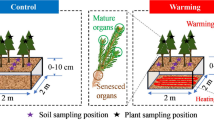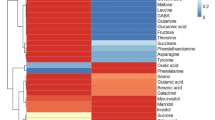Abstract
In the terrestrial bromeliad, Puya floccosa, a value of carbon isotopic composition (δ13C) of −22‰ has been previously reported, suggesting the operation of weak and/or intermediate (C3-CAM) crassulacean acid metabolism (CAM). In order to characterize the operation of CAM in P. floccosa and its possible induction by drought, plants were grown in Caracas and subjected to four independent drought cycles. Additionally, since plants of this species grow in Venezuela in a large range of elevations, leaf samples were collected at elevations ranging from 725 to 2,100 m a.s.l. in the Venezuelan Andes and the Coastal Range, in order to evaluate the effect of elevation on CAM performance. Even though nocturnal acid accumulation occurred in both watered and droughted plants, mean ΔH+ was higher in droughted than watered plants [ΔH+ = 60.17.5 and 22.9 ± 5.2 μmol g−1(FM), respectively]. The majority of plants from all the natural populations sampled had low values of δ13C not differing significantly from those of C3 plants collected as standards and δ13C did not change with elevation. We conclude that P. floccosa is capable of a weak CAM activity, with a large variability among populations and drought experiments probably due to local and temporal differences in microclimatic variables and drought stress; elevation bears no influence on values of δ13C in this species.
Similar content being viewed by others
Abbreviations
- CAM:
-
crassulacean acid metabolism
- Chl:
-
chlorophyll
- DM:
-
dry mass
- FM:
-
fresh mass
- FM/A:
-
fresh mass per area
- RH:
-
relative humidity
- T:
-
air temperature
- Sm :
-
mesophyll succulence index
- TR:
-
total radiation
- TRint :
-
daily integrated TR
References
Arroyo, M.K., Medina, E., Ziegler, H.: Distribution and δ13C values of Portulacaceae species of the high Andes in northern Chile. — Bot. Acta 103: 291–295, 1990.
Benzing, D.H.: Bromeliaceae: Profile of an Adaptive Radiation. — Cambridge Univ. Press, Cambridge 2000.
Borland, A.M., Griffiths, H., Maxwell, C., Broadmeadow, M.S.J., Griffiths, N.M., Barnes, J.D.: On the ecophysiology of the Clusiaceae in Trinidad: expression of CAM in Clusia minor L. during the transition from wet to dry season and characterization of tree endemic species. — New Phytol. 122: 349–357, 1992.
Bruinsma, J.: The quantitative analysis of chlorophylls a and b in plant extracts. — Photochem. Photobiol. 2: 241–249, 1963.
Diaz, M., Haag-Kerwer, A., Wingfield, R., Ball, E., Olivares, E., Grams, T.E.E., Ziegler, H. Lüttge, U.: Relationships between carbon and hydrogen isotope rations and nitrogen levels in leaves of Clusia species and two other Clusiaceae genera at various sites and different altitudes in Venezuela. — Trees 10: 351–358, 1996.
Farquhar, G.D., Richards, R.A.: Isotopic composition of plant carbon correlates with water-use efficiency of wheat genotypes. — Aust. J. Plant Physiol. 11: 539–552, 1984.
Herrera, A.: Crassulacean acid metabolism and fitness under water deficit stress: if not for carbon gain, what is facultative CAM good for? — Ann. Bot. 103: 645–653, 2009.
Herrera, A., Ballestrini, C., Tezara, W.: Nocturnal sap flow in the C3-CAM species, Clusia minor. — Trees 22: 491–497, 2008.
Huber, O.: La selva nublada de Rancho Grande, Parque Nacional de Henri Pittier. — In: Huber, O. (ed.): El Clima. Fondo Editorial Acta Científica Venezolana. Pp. 17–30, Caracas 1986. [In Spanish.]
Kalisz, S., Teeri, J.A.: Population-level variation in photosynthetic metabolism and growth in Sedum wrightii. — Ecol. 67: 20–26, 1986.
Keeley, J.E., Keeley, S.C.: Crassulacean acid metabolism (CAM) in high elevation tropical cactus. Plant Cell Environ. 12: 331–336, 1989.
Kluge, M., Ting, I.P.: Crassulacean Acid Metabolism. Analysis of an Ecological Adaptation. — Springer-Verlag, Berlin — Heidelberg — New York 1978.
Martin, C.E.: Physiological ecology of the Bromeliaceae. — Bot. Rev. 60: 1–82, 1994.
Medina, E.: Dark CO2 fixation, habitat preference and evolution within the Bromeliaceae. — Evolution 28: 677–686, 1974.
Medina, E., Delgado, M.: Photosynthesis and night CO2 fixation in Echeveria columbiana v. Poellnitz. — Photosynthetica 10: 155–163, 1976.
Medina, E., Delgado, M., Troughton, J.H., Medina, J.D.: Physiological ecology of CO2 fixation in Bromeliaceae. — Flora 166: 137–152, 1977.
Medina E, Troughton, J.H.: Dark CO2 fixation and the carbon isotope ratio in Bromeliaceae. — Plant Sci. Lett. 2: 357–362, 1974.
Nobel, P.S. Environmental Biology of Agaves and Cacti. — Cambridge University Press, Cambridge — New York — New Rochelle — Melbourne — Sydney 1988.
Reinert, F., Russo, C.A.M., Salles, L.O.: The evolution of CAM in the subfamily Pitcairnioideae (Bromeliaceae). — Biol. J. Linn. Soc. 80: 261–268, 2003.
Acknowledgements
Determinations of δ13C were kindly performed by J.P. Ometto and L. Martinelli at Centro de Energia Nuclear na Agricultura, Universidad de Sâo Paulo, Laboratório de Ecología Isotópica, Piracicaba, Brasil and E. Montes, Paleolab, University of Massachussets. Field trips were partly financed by Posgrado de Botánica, Universidad Central de Venezuela. D. Núñez did many of the acid titrations.
Author information
Authors and Affiliations
Corresponding author
Rights and permissions
About this article
Cite this article
Herrera, A., Martin, C.E., Tezara, W. et al. Induction by drought of crassulacean acid metabolism in the terrestrial bromeliad, Puya floccosa . Photosynthetica 48, 383–388 (2010). https://doi.org/10.1007/s11099-010-0050-3
Received:
Accepted:
Published:
Issue Date:
DOI: https://doi.org/10.1007/s11099-010-0050-3




